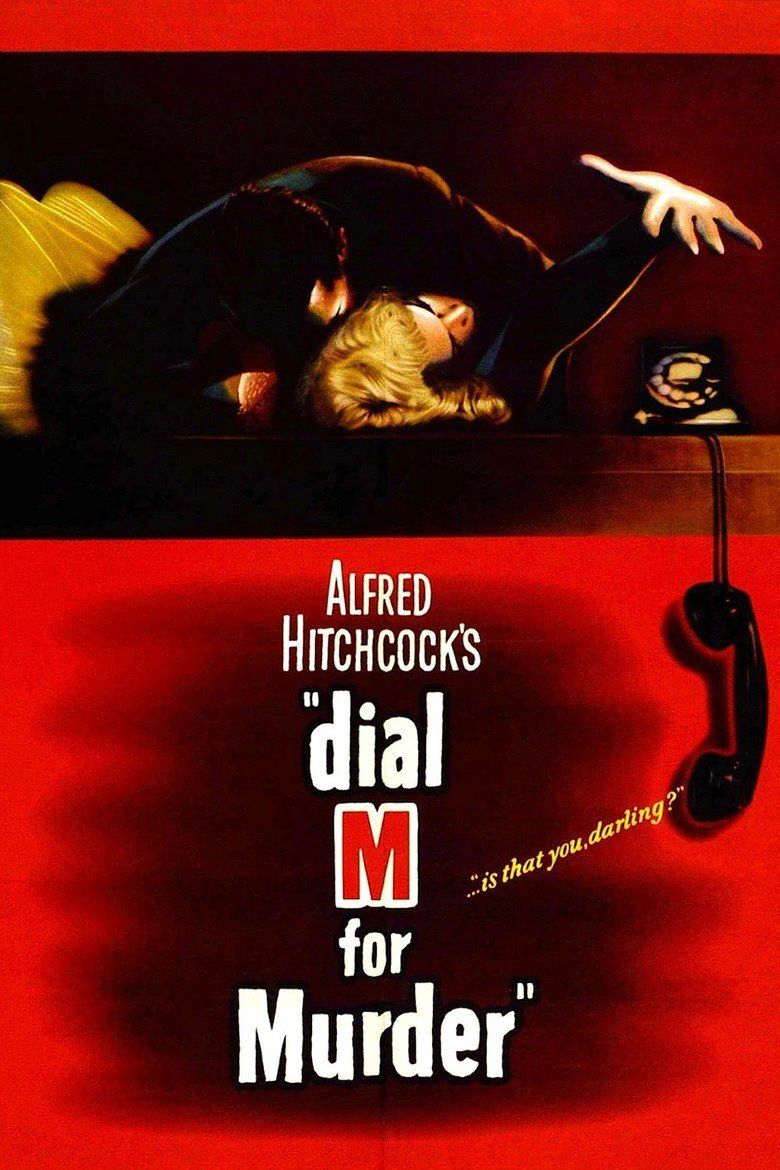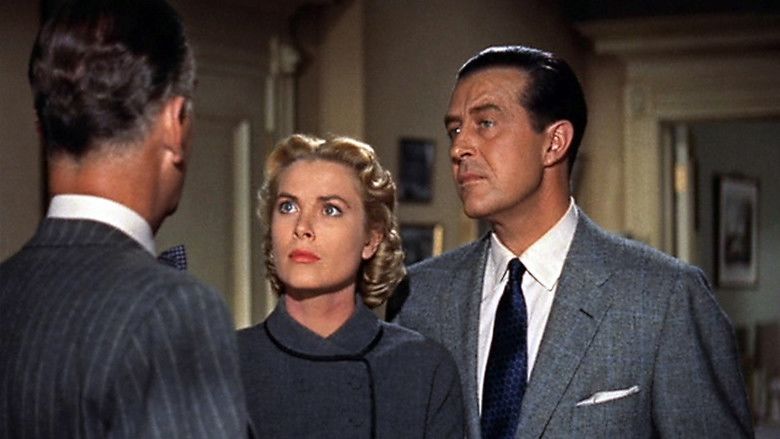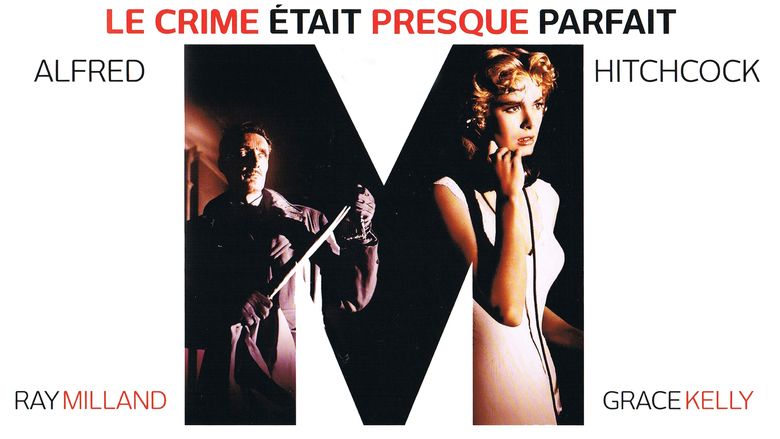Dial M for Murder
8.6 /10 1 Votes
88% Rotten Tomatoes Genre Crime, Thriller Country United States | 8.2/10 IMDb Duration Language English | |||||||||||||||||||||||||||||||||
 | ||||||||||||||||||||||||||||||||||
Release date May 29, 1954 (1954-05-29) Based on Play: (1952)Frederick Knott Writer Frederick Knott (screen play), Frederick Knott (adapted from his play) Initial release May 28, 1954 (New York City) Cast (Tony Wendice), (Margot Mary Wendice), (Mark Halliday), (Chief Insp. Hubbard), (Charles Alexander Swann aka Captain Lesgate), (The Storyteller) Similar movies Mad Max: Fury Road , Blackhat , Salt , Sin City: A Dame to Kill For , Mission: Impossible III , The Boy Next Door Tagline If a woman answers...hang on for dear life! | ||||||||||||||||||||||||||||||||||
Dial m for murder 1954 official trailer alfred hitchcock grace kelly movie hd
Dial M for Murder is a 1954 American crime mystery film directed by Alfred Hitchcock, starring Ray Milland, Grace Kelly, Robert Cummings and John Williams. It was filmed in 3-D with the technology that was available at the time, and is often considered one of the greatest 3D films ever made. The screenplay and the successful stage play on which it was based were written by English playwright Frederick Knott. The play premiered in 1952 on BBC Television, before being performed on stage in the same year in London's West End in June, and then New York's Broadway in October. The movie was released by Warner Bros., though due to the then-waning popularity of 3D films, it was converted to 2D, and only showed in its native 3D format in a small handful of cinemas.
Contents
- Dial m for murder 1954 official trailer alfred hitchcock grace kelly movie hd
- Dial m for murder 1954 movie trailer
- Plot
- Cast
- Production
- 3 D release
- Reception
- Similar films and remakes
- References

Dial m for murder 1954 movie trailer
Plot

Tony Wendice (Ray Milland), an English professional tennis player, is married to wealthy socialite Margot (Grace Kelly), who has had an affair with American crime-fiction writer Mark Halliday (Robert Cummings). When Tony retires from tennis in response to Margot's complaints about his busy schedule, he secretly discovers the affair and decides to murder her, both for revenge and to ensure that her money will continue to finance his comfortable lifestyle.

Tony invites an old acquaintance from the University of Cambridge, Charles Alexander "C. A." Swann (Anthony Dawson), to his London flat. Tony is aware that Swann has become a small-time criminal, and has been secretly following Swann so he can blackmail him into murdering Margot. Tony tells Swann about Margot's affair. Six months before, Tony stole her handbag, which contained a love letter from Mark, and anonymously blackmailed her. After tricking Swann into leaving his fingerprints on the letter, Tony offers to pay him £1,000 to kill Margot; if Swann refuses, Tony will turn him in to the police as Margot's blackmailer. Swann's credibility, in denying Tony's accusation, would be hurt by his criminal history.

When Swann agrees, Tony explains his plan: the following evening he will take Mark to a party, leaving Margot at home and hiding her latchkey outside the front door of their flat. Swann is to sneak in when Margot is asleep and hide behind the curtains in front of the French doors to the garden. At eleven o'clock, Tony will telephone the flat from the party. Swann must kill Margot when she answers the phone, open the French doors, leave signs suggesting a burglary gone wrong, and exit through the front door, hiding the key again.

The next night, Swann enters the flat while Margot is in bed, and waits. At the party, Tony discovers his watch has stopped, so he phones the flat later than intended. When Margot comes to the phone, Swann tries to strangle her with his scarf, but she manages to grab a pair of scissors and kill him. She picks up the telephone receiver and pleads for help. Tony tells her not to do anything until he arrives home. When he returns to the flat, he calls the police and sends Margot to bed. Before the police arrive, Tony moves what he thinks is Margot's latchkey from Swann's pocket into her handbag, plants Mark's letter on Swann, and destroys Swann's scarf, replacing it with Margot's own stocking in an attempt to incriminate her.

The following day, Tony persuades Margot to hide the fact that he told her not to call the police immediately. Chief Inspector Hubbard (John Williams) arrives and questions the Wendices, and Margot makes several conflicting statements. When Hubbard says Swann must have entered through the front door, Tony falsely claims to have seen Swann at the time Margot's handbag was stolen, and suggests that Swann made a copy of her key. Hubbard does not believe this because no key was found on Swann's body. Hubbard arrests Margot after concluding that she killed Swann for blackmailing her. Margot is found guilty and sentenced to death.

Some months later, on the day before Margot's scheduled execution, Mark visits Tony, saying he has devised a story for Tony to tell the police in order to save Margot's life. To Tony's consternation, Mark's "story" is what did actually happen: that Tony bribed Swann to murder Margot. Tony says the story is too unrealistic. Hubbard arrives unexpectedly, and Mark hides in the bedroom. Hubbard asks Tony about large sums of cash he has been spending, tricks him into revealing that his latchkey is in his raincoat, and inquires about Tony's attaché case. Tony claims to have lost the case, but Mark, still in the bedroom, finds it on the bed, full of banknotes. Deducing that the money was Tony's intended payoff to Swann, Mark stops Hubbard from leaving and explains his theory. Tony improvises another cover story by saying the cash was Margot's blackmail payment to Swann. Hubbard appears to accept Tony's explanation over Mark's theory, and Mark leaves angrily. Hubbard discreetly swaps his own raincoat with Tony's, and as soon as Tony leaves, Hubbard uses Tony's key to re-enter the flat, followed by Mark. Hubbard had already discovered that the key in Margot's handbag was Swann's own latchkey, and deduced that Swann had put the Wendices' key back in its hiding-place after unlocking the door. Now suspecting Tony of having conspired with Swann, Hubbard has developed an elaborate ruse to confirm this.
Plainclothes policemen bring Margot from prison to the flat. She tries unsuccessfully to unlock the door with the key in her handbag, then enters through the garden, proving she is unaware of the hidden key. Hubbard has Margot's handbag returned to the police station, where Tony retrieves it after discovering that he has no key. The key from Margot's bag does not work, so he uses the hidden key to open the door, proving his guilt. With his escape routes blocked by Hubbard and another policeman, Tony calmly makes himself a drink, congratulates Hubbard and admits defeat.
Cast
Production
After 1953's I Confess, Hitchcock planned to film The Bramble Bush, based on the 1948 novel by David Duncan, as a Transatlantic Pictures production, with partner Sidney Bernstein. However, there were problems with the script and budget, and Hitchcock and Bernstein decided to dissolve their partnership. Warner Bros. allowed Hitchcock to scrap the film, and begin production on Dial M for Murder.
Mark's name was changed for the film; in the original play, he was Max Halliday. Actors Dawson and Williams reprise their Broadway roles as Swann/Captain Lesgate and Inspector Hubbard, respectively.
Alfred Hitchcock's cameo is a signature occurrence in most of his films. In Dial M for Murder, he can be seen thirteen minutes into the film, in a black-and-white reunion photograph, sitting at a banquet table among former students and faculty.
3-D release
The 1954 film was shot using Warner Bros.' own proprietary 3-D camera rig, the so-called All-Media Camera. Originally intended to be shown in dual-strip polarized 3-D, the film played in most theaters in ordinary 2-D due to the loss of interest in the 3-D process (the projection of which was difficult and error-prone) by the time of its release.
The film earned an estimated $2.7 million at the North American box office in 1954. Dial M for Murder marked the end of the brief flirtation with 3-D films of the early 1950s. Hitchcock said of 3-D, "It's a nine-day wonder, and I came in on the ninth day."
In February 1980, the dual-strip system was used for the revival of the film in 3-D at the York Theater in San Francisco. This revival did so well that Warner Bros. did a limited national re-release of the film in February 1982, using Chris Condon's single-strip StereoVision 3-D system, including a sold out engagement at the Detroit Institute of Arts.
Warner Bros. released Dial M for Murder as a 3D Blu-ray on October 9, 2012.
The film was shown in 3D in some UK cinemas during the summer of 2013, and in Italy at the beginning of fall of the same year.
Reception
The film holds an approval rating of 88% on the review aggregation website Rotten Tomatoes. The site's critical consensus reads: "Dial M for Murder may be slightly off-peak Hitchcock, but by any other standard, it's a sophisticated, chillingly sinister thriller -- and one that boasts an unforgettable performance from Grace Kelly to boot".
The film was listed by American Film Institute in 2001 in AFI's 100 Years...100 Thrills (#48), and in 2008 in AFI's 10 Top 10 (#9 in Mysteries).
Similar films and remakes
As it is considered one of the classic examples of a stage thriller, it has been revived a number of times since, including a US TV film in 1981 with Angie Dickinson and Christopher Plummer. The American Broadcasting Company (ABC) produced a two-hour color version in 1968 featuring Laurence Harvey as Tony, Diane Cilento as Margot and Hugh O'Brian as Max.
A Perfect Murder is a 1998 remake directed by Andrew Davis in which the characters of Halliday and Swann are combined, with the husband (Michael Douglas) both hiring and coercing his wife's lover (played by Viggo Mortensen) into a scheme to kill her (Gwyneth Paltrow). However, the lover hatches a revenge plot against the husband. Things go disastrously wrong for both of them, bringing in the cold, smoothly dogged police inspector (David Suchet), whose role is much reduced, as it is Gwyneth Paltrow's character, the wife, who unravels much of the mystery.
The television series Alfred Hitchcock Presents premiered in the United States the year after Dial M for Murder was released. The main character in an episode from the series's first season, "Portrait of Jocelyn", is named Mark Halliday. In the episode, Halliday's wife, Jocelyn, has disappeared several years earlier, and at the conclusion, it is revealed that he murdered her.
The original play was also adapted in the Soviet Union in 1981 under the title Tony Wendice's Mistake (Ошибка Тони Вендиса).
The film partially inspired a Hindi-language version in 1985, released as Aitbaar, starring Raj Babbar, Dimple Kapadia and Suresh Oberoi. A Tamil-language adaptation, titled Saavi, with Sathyaraj, Saritha, Jaishankar and Nizhalgal Ravi, was released in the same year. The film also inspired a Malayalam-language adaptation as New Year starring Jayaram, Urvashi and Suresh Gopi in 1989. Another Bollywood film, Humraaz (2002), starring Bobby Deol, Akshaye Khanna, and Amisha Patel, was inspired by A Perfect Murder.
The episode "The Fifth Stair" of the TV series 77 Sunset Strip recreated Dial M for Murder, with Richard Long portraying Tony Wendice.
The third episode of the sixth season of Frasier is titled "Dial M for Martin". The plot centres on the title character's father believing that his younger son is subconsciously trying to kill him when he is beset by a series of mishaps seemingly caused by Frasier's younger brother, Niles.
References
Dial M for Murder WikipediaDial M for Murder IMDbDial M for Murder Rotten TomatoesDial M for Murder themoviedb.org
